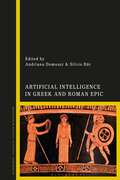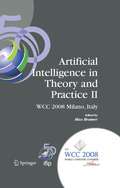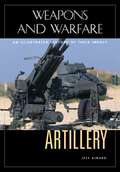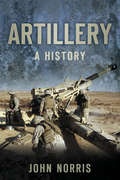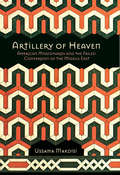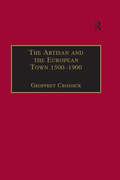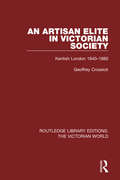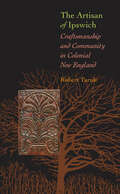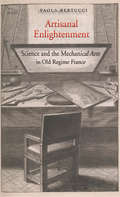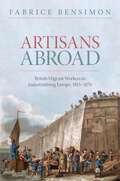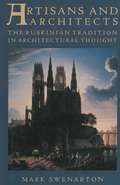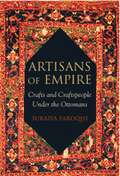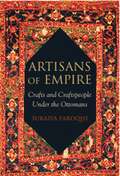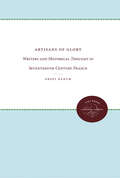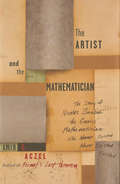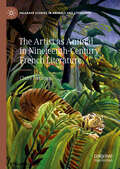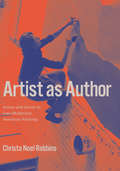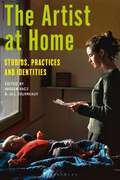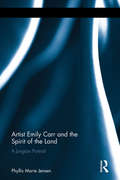- Table View
- List View
Artificial Intelligence in Greek and Roman Epic
by Andriana Domouzi and Silvio BärThis is the first scholarly exploration of concepts and representations of Artificial Intelligence in ancient Greek and Roman epic, including their reception in later literature and culture. Contributors look at how Hesiod, Homer, Apollonius of Rhodes, Moschus, Ovid and Valerius Flaccus crafted the first literary concepts concerned with automata and the quest for artificial life, as well as technological intervention improving human life.Parts one and two consider, respectively, archaic Greek, and Hellenistic and Roman, epics. Contributors explore the representations of Pandora in Hesiod, and Homeric automata such as Hephaestus' wheeled tripods, the Phaeacian king Alcinous' golden and silver guard dogs, and even the Trojan Horse. Later examples cover Artificial Intelligence and automation (including Talos) in the Argonautica of Apollonius and Valerius Flaccus, and Pygmalion's ivory woman in Ovid's Metamorphoses. Part three underlines how these concepts benefit from analysis of the ekphrasis device, within which they often feature. These chapters investigate the cyborg potential of the epic hero and the literary implications of ancient technology. Moving into contemporary examples, the final chapters consider the reception of ancient literary Artificial Intelligence in contemporary film and literature, such as the Czech science-fiction epic Starvoyage, or Small Cosmic Odyssey by Jan Kr?esadlo (1995) and the British science-fiction novel The Holy Machine by Chris Beckett (2004).
Artificial Intelligence in Greek and Roman Epic
This is the first scholarly exploration of concepts and representations of Artificial Intelligence in ancient Greek and Roman epic, including their reception in later literature and culture. Contributors look at how Hesiod, Homer, Apollonius of Rhodes, Moschus, Ovid and Valerius Flaccus crafted the first literary concepts concerned with automata and the quest for artificial life, as well as technological intervention improving human life.Parts one and two consider, respectively, archaic Greek, and Hellenistic and Roman, epics. Contributors explore the representations of Pandora in Hesiod, and Homeric automata such as Hephaestus' wheeled tripods, the Phaeacian king Alcinous' golden and silver guard dogs, and even the Trojan Horse. Later examples cover Artificial Intelligence and automation (including Talos) in the Argonautica of Apollonius and Valerius Flaccus, and Pygmalion's ivory woman in Ovid's Metamorphoses. Part three underlines how these concepts benefit from analysis of the ekphrasis device, within which they often feature. These chapters investigate the cyborg potential of the epic hero and the literary implications of ancient technology. Moving into contemporary examples, the final chapters consider the reception of ancient literary Artificial Intelligence in contemporary film and literature, such as the Czech science-fiction epic Starvoyage, or Small Cosmic Odyssey by Jan Kr?esadlo (1995) and the British science-fiction novel The Holy Machine by Chris Beckett (2004).
Artificial Intelligence in Theory and Practice II: IFIP 20th World Computer Congress, TC 12: IFIP AI 2008 Stream, September 7-10, 2008, Milano, Italy (IFIP Advances in Information and Communication Technology #276)
by Max BramerThe papers in this volume comprise the refereed proceedings of the conference ‘ Artificial Intelligence in Theory and Practice’ (IFIP AI 2008), which formed part of the 20th World Computer Congress of IFIP, the International Federation for Information Processing (WCC-2008), in Milan, Italy in September 2008. The conference is organised by the IFIP Technical Committee on Artificial Intelligence (Technical Committee 12) and its Working Group 12.5 (Artificial Intelligence Applications). All papers were reviewed by at least two members of our Program Committee. Final decisions were made by the Executive Program Committee, which comprised John Debenham (University of Technology, Sydney, Australia), Ilias Maglogiannis (University of Aegean, Samos, Greece), Eunika Mercier-Laurent (KIM, France) and myself. The best papers were selected for the conference, either as long papers (maximum 10 pages) or as short papers (maximum 5 pages) and are included in this volume. The international nature of IFIP is amply reflected in the large number of countries represented here. The conference also featured invited talks by Prof. Nikola Kasabov (Auckland University of Technology, New Zealand) and Prof. Lorenza Saitta (University of Piemonte Orientale, Italy). I should like to thank the conference chair, John Debenham for all his efforts and the members of our program committee for reviewing papers to a very tight deadline.
Artillery: An Illustrated History of Its Impact (Weapons and Warfare)
by Jeff KinardAddressing its technical evolution as well as its military and social impact, this comprehensive reference shows how historic leaders such as Dionysus of Syracuse, the Ottoman sultan Mohammad II, Oliver Cromwell, and Napoleon Bonaparte were successful in battle because of their innovative use of artillery.Artillery: An Illustrated History of Its Impact charts the development of large, crew-operated battlefield weapons from the dart firers and catapults of the ancient world to the invention of gunpowder in China and its applications in medieval Europe, and from the emergence of naval and land gunnery four centuries ago to the latest rapid-fire, rocket propulsion, laser guidance, and antiaircraft technologies.Written by an expert on military history, Artillery explores the technological and strategic innovations that have made these weapons increasingly effective at breaking through fortifications, inflicting casualties from a safe distance, providing cover for advancing forces, demoralizing opponents, and defending positions from attack. Beyond the battlefield, the book also looks at the impact of artillery on history and on the lives of civilians as well as soldiers.
Artillery of Heaven: American Missionaries and the Failed Conversion of the Middle East (The United States in the World)
by Ussama MakdisiThe complex relationship between America and the Arab world goes back further than most people realize. In Artillery of Heaven, Ussama Makdisi presents a foundational American encounter with the Arab world that occurred in the nineteenth century, shortly after the arrival of the first American Protestant missionaries in the Middle East. He tells the dramatic tale of the conversion and death of As'ad Shidyaq, the earliest Arab convert to American Protestantism. The struggle over this man's body and soul—and over how his story might be told—changed the actors and cultures on both sides. In the unfamiliar, multireligious landscape of the Middle East, American missionaries at first conflated Arabs with Native Americans and American culture with an uncompromising evangelical Christianity. In turn, their Christian and Muslim opponents in the Ottoman Empire condemned the missionaries as malevolent intruders. Yet during the ensuing confrontation within and across cultures an unanticipated spirit of toleration was born that cannot be credited to either Americans or Arabs alone. Makdisi provides a genuinely transnational narrative for this new, liberal awakening in the Middle East, and the challenges that beset it.By exploring missed opportunities for cultural understanding, by retrieving unused historical evidence, and by juxtaposing for the first time Arab perspectives and archives with American ones, this book counters a notion of an inevitable clash of civilizations and thus reshapes our view of the history of America in the Arab world.
The Artisan and the European Town, 1500–1900 (Historical Urban Studies Series)
by Geoffrey CrossickArtisans played a central role in the European town as it developed from the Middles Ages onwards. Their workshops were at the heart of productive activity, their guilds were often central to the political and legal order of towns, and their culture helped shape civic ritual and the urban order. These essays, which have all been specially written for this collection, explore the relationships between artisans and their towns across Europe between the beginning of the early-modern period and the end of the 19th century. They pay special attention to the processes of economic, juridicial and political change that have made the 18th and early 19th centuries a period of such significance. Written by leading historians of European artisans, the essays question the myths about artisans that have long pervaded research in the field. The leading myth was that shared by the artisans themselves - the myth of decline and the belief in each generation that artisans in the past had inhabited a better age. These essays open up for debate the nature of artisanship, the way economic change affected craft production, the political role of artisans, the cultural identification of the artisans with work and masculinity, and the way changing urban society and changing urban structure posed threats to which the artisans had to respond.
The Artisan and the European Town, 1500–1900 (Historical Urban Studies Series)
by Geoffrey CrossickArtisans played a central role in the European town as it developed from the Middles Ages onwards. Their workshops were at the heart of productive activity, their guilds were often central to the political and legal order of towns, and their culture helped shape civic ritual and the urban order. These essays, which have all been specially written for this collection, explore the relationships between artisans and their towns across Europe between the beginning of the early-modern period and the end of the 19th century. They pay special attention to the processes of economic, juridicial and political change that have made the 18th and early 19th centuries a period of such significance. Written by leading historians of European artisans, the essays question the myths about artisans that have long pervaded research in the field. The leading myth was that shared by the artisans themselves - the myth of decline and the belief in each generation that artisans in the past had inhabited a better age. These essays open up for debate the nature of artisanship, the way economic change affected craft production, the political role of artisans, the cultural identification of the artisans with work and masculinity, and the way changing urban society and changing urban structure posed threats to which the artisans had to respond.
An Artisan Elite in Victorian Society: Kentish London 1840-1880 (Routledge Library Editions: The Victorian World)
by Geoffrey CrossickFirst published in 1978. Mid-Victorian Britain was relatively stable in comparison with the turbulent period that preceded it, and that stability is in part explained by the emergence of an artisan elite with a specific relationship to the society around it. This book examines that elite: its clubs and societies, co-operatives and building societies; its values and ideology, challenging the notion that these artisans directly absorbed middle-class values; its politics, tracing the evolution from Chartism through the Reform League and on to a radical liberalism which existed in constant tension with the local liberal middle class. A careful reconstruction of the social, political and industrial life of these artisans is set within the context of the local communities, and their understanding of the mid-Victorian society in which they lived is seen as the explanation for their values and activities. This title makes a major contribution towards our understanding of the nineteenth-century working class.
An Artisan Elite in Victorian Society: Kentish London 1840-1880 (Routledge Library Editions: The Victorian World)
by Geoffrey CrossickFirst published in 1978. Mid-Victorian Britain was relatively stable in comparison with the turbulent period that preceded it, and that stability is in part explained by the emergence of an artisan elite with a specific relationship to the society around it. This book examines that elite: its clubs and societies, co-operatives and building societies; its values and ideology, challenging the notion that these artisans directly absorbed middle-class values; its politics, tracing the evolution from Chartism through the Reform League and on to a radical liberalism which existed in constant tension with the local liberal middle class. A careful reconstruction of the social, political and industrial life of these artisans is set within the context of the local communities, and their understanding of the mid-Victorian society in which they lived is seen as the explanation for their values and activities. This title makes a major contribution towards our understanding of the nineteenth-century working class.
The Artisan of Ipswich: Craftsmanship and Community in Colonial New England
by Robert TaruleThomas Dennis emigrated to America from England in 1663, settling in Ipswich, a Massachusetts village a long day's sail north of Boston. He had apprenticed in joinery, the most common method of making furniture in sixteenth- and seventeenth-century Britain, and he became Ipswich's second joiner, setting up shop in the heart of the village. During his lifetime, Dennis won wide renown as an artisan. Today, connoisseurs judge his elaborately carved furniture as among the best produced in seventeenth-century America.Robert Tarule, historian and accomplished craftsman, brilliantly recreates Dennis's world in recounting how he created a single oak chest. Writing as a woodworker himself, Tarule vividly portrays Dennis walking through the woods looking for the right trees; sawing and splitting the wood on site; and working in his shop on the chest—planing, joining, and carving. Dennis inherited a knowledge of wood and woodworking that dated back centuries before he was born, and Tarule traces this tradition from Old World to New. He also depicts the natural and social landscape in which Dennis operated, from the sights, sounds, and smells of colonial Ipswich and its surrounding countryside to the laws that governed his use of trees and his network of personal and professional relationships.Thomas Dennis embodies a world that had begun to disappear even during his lifetime, one that today may seem unimaginably distant. Imaginatively conceived and elegantly executed, The Artisan of Ipswich gives readers a tangible understanding of that distant past.
Artisanal Enlightenment: Science and the Mechanical Arts in Old Regime France
by Paola BertucciA groundbreaking work that places the mechanical arts and the world of making at the heart of the Enlightenment What would the Enlightenment look like from the perspective of artistes, the learned artisans with esprit, who presented themselves in contrast to philosophers, savants, and routine-bound craftsmen? Making a radical change of historical protagonists, Paola Bertucci places the mechanical arts and the world of making at the heart of the Enlightenment. At a time of great colonial, commercial, and imperial concerns, artistes planned encyclopedic projects and sought an official role in the administration of the French state. The Société des Arts, which they envisioned as a state institution that would foster France’s colonial and economic expansion, was the most ambitious expression of their collective aspirations. Artisanal Enlightenment provides the first in-depth study of the Société, and demonstrates its legacy in scientific programs, academies, and the making of Diderot and D’Alembert’s Encyclopédie. Through insightful analysis of textual, visual, and material sources, Bertucci provides a groundbreaking perspective on the politics of writing on the mechanical arts and the development of key Enlightenment concepts such as improvement, utility, and progress.
Artisans Abroad: British Migrant Workers in Industrialising Europe, 1815-1870
by Fabrice BensimonBetween 1815 and 1870, when European industrialisation was in its infancy and Britain enjoyed a technological lead, thousands of British workers emigrated to the continent. They played a key role in several sectors, like textiles, iron, mechanics, and the railways. These men and women thereby contributed significantly to the industrial take-off in continental Europe. Artisans Abroad examines the lives and trajectories of these workers who emigrated from manufacturing centres in Britain to France, Belgium, Germany, and other countries, considering their mobilities, their culture, their politics, and their relations with the local populations. Fabrice Bensimon reminds us that the British economy was not just oriented towards the Empire and the USA, but also towards the continent, long before the European Union and Brexit, and shows the critical role played by migrant workers in the Industrial Revolution. Artisans Abroad is the first social and cultural history of this forgotten migration.
Artisans of Empire: Crafts and Craftspeople Under the Ottomans
by Suraiya FaroqhiThe manufacture and trade in crafted goods and the men and women who were involved in this industry - including metalworkers, ceramicists, silk weavers, fez-makers, blacksmiths and even barbers - lay at the social as well as the economic heart of the Ottoman empire. This comprehensive history by leading Ottoman historian Suraiya Faroqhi presents the definitive view of the subject, from the production and distribution of different craft objects to their use and enjoyment within the community.Succinct yet comprehensive, "Artisans of Empire" analyses the production and trade of crafts from the beginning of the 16th century to the early 20th century, focusing on its history, politics and culture. Production methods, the organisation of trade guilds, religious differences, the contribution of women and the structure of the Ottoman economy all come under scrutiny in this wide-ranging history that combines keen analysis with descriptions of the beautiful and sometimes unknown works of Ottoman artisans. Faroqhi sheds new light on all aspects of artisan life, setting the concerns of individual craftsmen within the context of the broader cultural themes that connect them to the wider world.Combining social, cultural, economic, religious and historiographical insights, this will be the authoritative work on Ottoman artisans and guilds for many years to come.
Artisans of Empire: Crafts and Craftspeople Under the Ottomans (Library Of Ottoman Studies #20161030)
by Suraiya FaroqhiThe manufacture and trade in crafted goods and the men and women who were involved in this industry - including metalworkers, ceramicists, silk weavers, fez-makers, blacksmiths and even barbers - lay at the social as well as the economic heart of the Ottoman empire. This comprehensive history, by leading Ottoman historian Suraiya Faroqhi, presents the definitive view of the subject, from the production and distribution of different craft objects to their use and enjoyment within the community. Faroqhi sheds new light on all aspects of artisan life, setting the concerns of individual craftsmen within the context of the broader cultural themes that connect them to the wider world. Combining social, cultural, economic, religious and historical insights, this will be the authoritative work on Ottoman artisans and guilds for many years to come.'A display of unrivalled knowledge of the sources by one of the leading historians of the Ottoman Empire.' - Erik J. Zürcher, Professor of Turkish Studies at the University of Leiden
Artisans of Glory: Writers and Historical Thought in Seventeenth-Century France
by Orest RanumRanum analyzes the canons of writing history and describes the lives and achievements of the royal French historiographers. He examines the manner in which these writers described and, in some sense, created the glory that surrounded the lives of the nobility, hoping by so doing to enhance their own glory. Through studying the careers of these men, the author demonstrates how rhetorical, ideological, and social beliefs determined the way history was written.Originally published in 1980.A UNC Press Enduring Edition -- UNC Press Enduring Editions use the latest in digital technology to make available again books from our distinguished backlist that were previously out of print. These editions are published unaltered from the original, and are presented in affordable paperback formats, bringing readers both historical and cultural value.
The Artist and the Mathematician: The Story Of Nicolas Bourbaki, The Genius Mathematician Who Never Existed
by Amir D. AczelNicolas Bourbaki, whose mathematical publications began to appear in the late 1930s and continued to be published through most of the twentieth century, was a direct product as well as a major force behind an important revolution that took place in the early decades of the twentieth century that completely changed Western culture. Pure mathematics, the area of Bourbaki's work, seems on the surface to be an abstract field of human study with no direct connection with the real world. In reality, however, it is closely intertwined with the general culture that surrounds it. Major developments in mathematics have often followed important trends in popular culture; developments in mathematics have acted as harbingers of change in the surrounding human culture. The seeds of change, the beginnings of the revolution that swept the Western world in the early decades of the twentieth century - both in mathematics and in other areas - were sown late in the previous century. This is the story both of Bourbaki and the world that created him in that time. It is the story of an elaborate intellectual joke - because Bourbaki, one of the foremost mathematicians of his day - never existed.
The Artist as Animal in Nineteenth-Century French Literature (Palgrave Studies in Animals and Literature)
by Claire NettletonThe Artist as Animal in Nineteenth-Century French Literature traces the evolution of the relationship between artists and animals in fiction from the Second Empire to the fin de siècle. This book examines examples of visual literature, inspired by the struggles of artists such as Edouard Manet and Vincent van Gogh. Edmond and Jules de Goncourt’s Manette Salomon (1867), Émile Zola’s Therèse Raquin (1867), Jules Laforgue’s “At the Berlin Aquarium” (1895) and “Impressionism” (1883), Octave Mirbeau’s In the Sky (1892-1893) and Rachilde’s L’Animale (1893) depict vanguard painters and performers as being like animals, whose unique vision revolted against stifling traditions. Juxtaposing these literary works with contemporary animal theory (McHugh, Deleuze, Guattari and Derrida), zoo studies (Berger, Rothfels and Lippit) and feminism (Donovan, Adams and Haraway), Claire Nettleton explores the extent to which the nineteenth-century dissolution of the human subject contributed to a radical, modern aesthetic. Utilizing these interdisciplinary methodologies, Nettleton argues that while inducing anxiety regarding traditional humanist structures, the “artist-animal,” an embodiment of artistic liberation within an urban setting, is, at the same time, a paradigmatic trope of modernity.
Artist as Author: Action and Intent in Late-Modernist American Painting
by Christa Noel RobbinsWith Artist as Author, Christa Noel Robbins provides the first extended study of authorship in mid-20th century abstract painting in the US. Taking a close look at this influential period of art history, Robbins describes how artists and critics used the medium of painting to advance their own claims about the role that they believed authorship should play in dictating the value, significance, and social impact of the art object. Robbins tracks the subject across two definitive periods: the “New York School” as it was consolidated in the 1950s and “Post Painterly Abstraction” in the 1960s. Through many deep dives into key artist archives, Robbins brings to the page the minds and voices of painters Arshile Gorky, Jack Tworkov, Helen Frankenthaler, Kenneth Noland, Sam Gilliam, and Agnes Martin along with those of critics such as Harold Rosenberg and Rosalind Krauss. While these are all important characters in the polemical histories of American modernism, this is the first time they are placed together in a single study and treated with equal measure, as peers participating in the shared late modernist moment.
Artist as Author: Action and Intent in Late-Modernist American Painting
by Christa Noel RobbinsWith Artist as Author, Christa Noel Robbins provides the first extended study of authorship in mid-20th century abstract painting in the US. Taking a close look at this influential period of art history, Robbins describes how artists and critics used the medium of painting to advance their own claims about the role that they believed authorship should play in dictating the value, significance, and social impact of the art object. Robbins tracks the subject across two definitive periods: the “New York School” as it was consolidated in the 1950s and “Post Painterly Abstraction” in the 1960s. Through many deep dives into key artist archives, Robbins brings to the page the minds and voices of painters Arshile Gorky, Jack Tworkov, Helen Frankenthaler, Kenneth Noland, Sam Gilliam, and Agnes Martin along with those of critics such as Harold Rosenberg and Rosalind Krauss. While these are all important characters in the polemical histories of American modernism, this is the first time they are placed together in a single study and treated with equal measure, as peers participating in the shared late modernist moment.
The Artist at Home: Studios, Practices and Identities
by Imogen Racz and Jill JourneauxArtists have worked from home for many reasons, including care duties, financial or political constraints, or availability and proximity to others.From the 'home studios' of Charles and Ray Eames, to the different photographic representations of Robert Rauschenberg's studio, this book explores the home as a distinct site of artistic practice, and the traditions and developments of the home studio as concept and space throughout the 20th and into the 21st century.Using examples from across Europe and the Anglophone world between the mid-20th century and the present, each chapter considers the different circumstances for working at home, the impact on the creative lives of the artists, their identities as artists and on the work itself, and how, sometimes, these were projected and promoted through photographs and the media. Key themes include the gendered and performative aspects of women practising 'at home', collaborative studio communities of the 1970s – 90s including the appropriation of abandoned spaces in East London, and the effects of Covid on artistic practices and family life within the spaces of 'home'. The book comprises full-length chapters by artists, architects, art and design historians, each of whom bring different perspectives to the issues, interwoven with short interviews with artists to enrich and broaden the debates. At a time when individual relationships to home environments have been radically altered, The Artist at Home considers why some artists in previous decades either needed to or chose to work from home, producing work of vitality and integrity. Tracing this long tradition into the present, the book will provide a deeper understanding of how the home studio has affected the practices and identity of artists working in different countries, and in different circumstances, from the mid-20th century to the present.
The Artist at Home: Studios, Practices and Identities
Artists have worked from home for many reasons, including care duties, financial or political constraints, or availability and proximity to others.From the 'home studios' of Charles and Ray Eames, to the different photographic representations of Robert Rauschenberg's studio, this book explores the home as a distinct site of artistic practice, and the traditions and developments of the home studio as concept and space throughout the 20th and into the 21st century.Using examples from across Europe and the Anglophone world between the mid-20th century and the present, each chapter considers the different circumstances for working at home, the impact on the creative lives of the artists, their identities as artists and on the work itself, and how, sometimes, these were projected and promoted through photographs and the media. Key themes include the gendered and performative aspects of women practising 'at home', collaborative studio communities of the 1970s – 90s including the appropriation of abandoned spaces in East London, and the effects of Covid on artistic practices and family life within the spaces of 'home'. The book comprises full-length chapters by artists, architects, art and design historians, each of whom bring different perspectives to the issues, interwoven with short interviews with artists to enrich and broaden the debates. At a time when individual relationships to home environments have been radically altered, The Artist at Home considers why some artists in previous decades either needed to or chose to work from home, producing work of vitality and integrity. Tracing this long tradition into the present, the book will provide a deeper understanding of how the home studio has affected the practices and identity of artists working in different countries, and in different circumstances, from the mid-20th century to the present.
Artist Emily Carr and the Spirit of the Land: A Jungian Portrait
by Phyllis Marie JensenEmily Carr, often called Canada’s Van Gogh, was a post-impressionist explorer, artist and writer. In Artist Emily Carr and the Spirit of the Land Phyllis Marie Jensen draws on analytical psychology and the theories of feminism and social constructionism for insights into Carr’s life in the late Victorian period and early twentieth century. Presented in two parts, the book introduces Carr’s émigré English family and childhood on the "edge of nowhere" and her art education in San Francisco, London and Paris. Travels in the wilderness introduced her to the totem art of the Pacific Northwest coast at a time Aboriginal art was undervalued and believed to be disappearing. Carr vowed to document it before turning to spirited landscapes of forest, sea and sky. The second part of the book presents a Jungian portrait of Carr, including typology, psychological complexes, and archetypal features of personality. An examination the individuation process and Carr’s embracement of transcendental philosophy reveals the richness of her personality and artistic genius. Artist Emily Carr and the Spirit of the Land provides captivating reading for analytical psychologists, academics and students of Jungian studies, art history, health, gender and women’s studies.
Artist Emily Carr and the Spirit of the Land: A Jungian Portrait
by Phyllis Marie JensenEmily Carr, often called Canada’s Van Gogh, was a post-impressionist explorer, artist and writer. In Artist Emily Carr and the Spirit of the Land Phyllis Marie Jensen draws on analytical psychology and the theories of feminism and social constructionism for insights into Carr’s life in the late Victorian period and early twentieth century. Presented in two parts, the book introduces Carr’s émigré English family and childhood on the "edge of nowhere" and her art education in San Francisco, London and Paris. Travels in the wilderness introduced her to the totem art of the Pacific Northwest coast at a time Aboriginal art was undervalued and believed to be disappearing. Carr vowed to document it before turning to spirited landscapes of forest, sea and sky. The second part of the book presents a Jungian portrait of Carr, including typology, psychological complexes, and archetypal features of personality. An examination the individuation process and Carr’s embracement of transcendental philosophy reveals the richness of her personality and artistic genius. Artist Emily Carr and the Spirit of the Land provides captivating reading for analytical psychologists, academics and students of Jungian studies, art history, health, gender and women’s studies.
